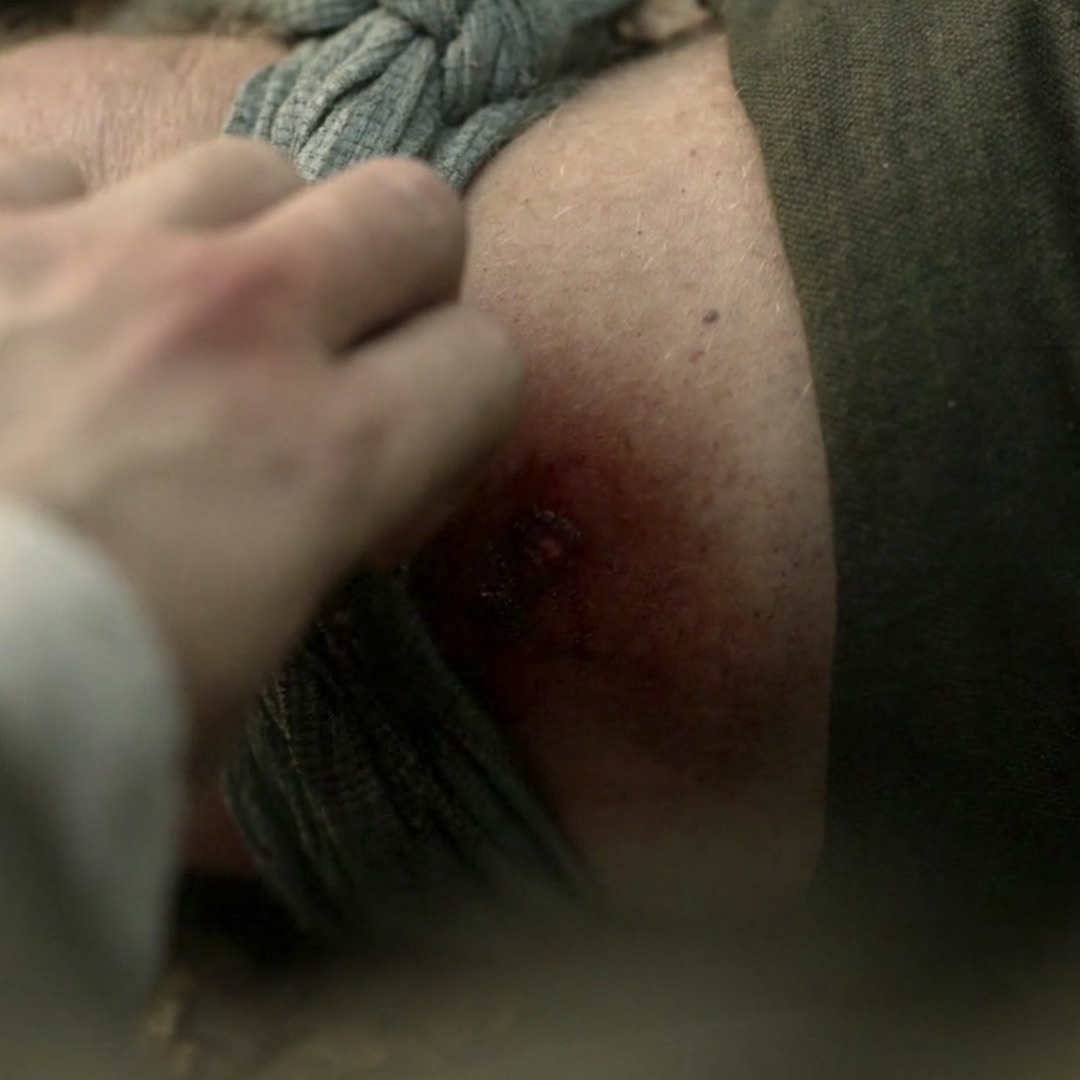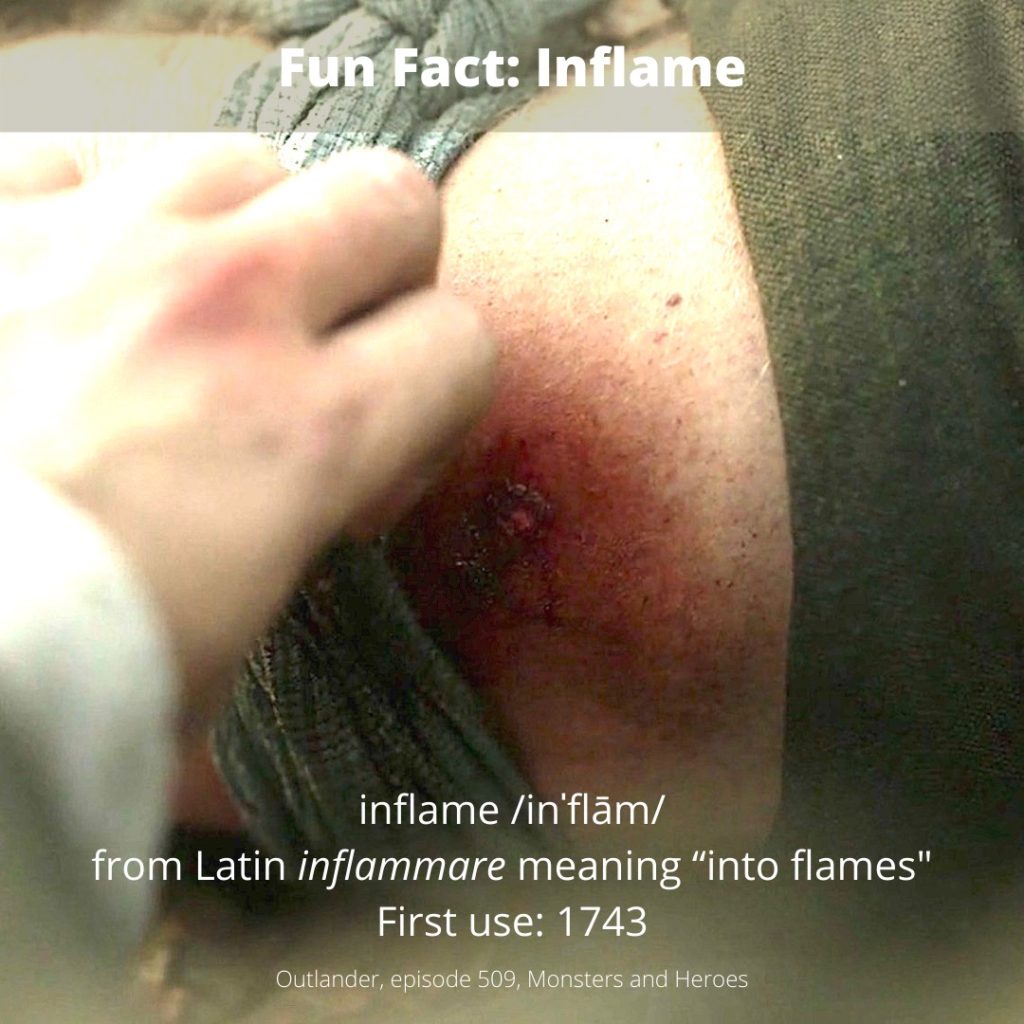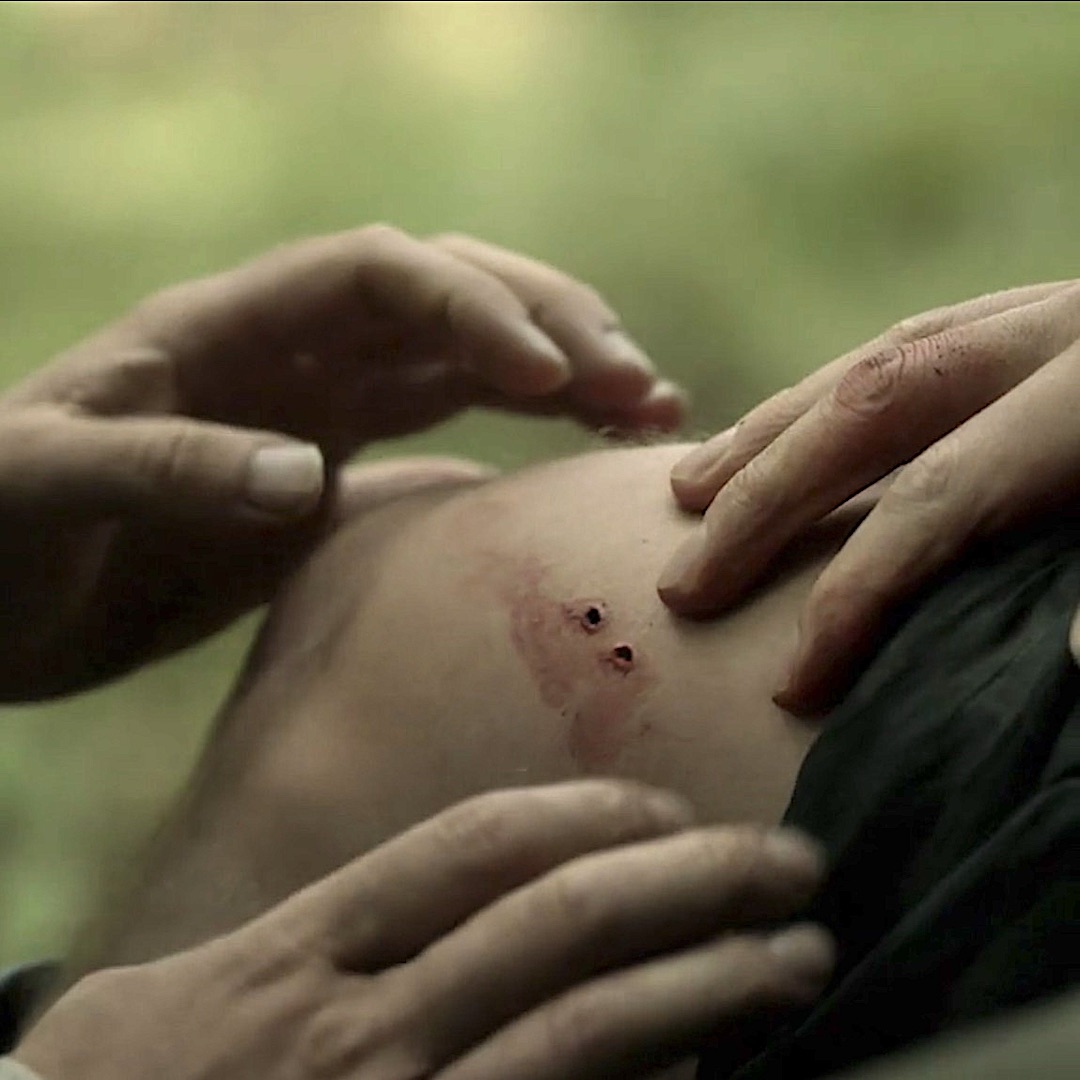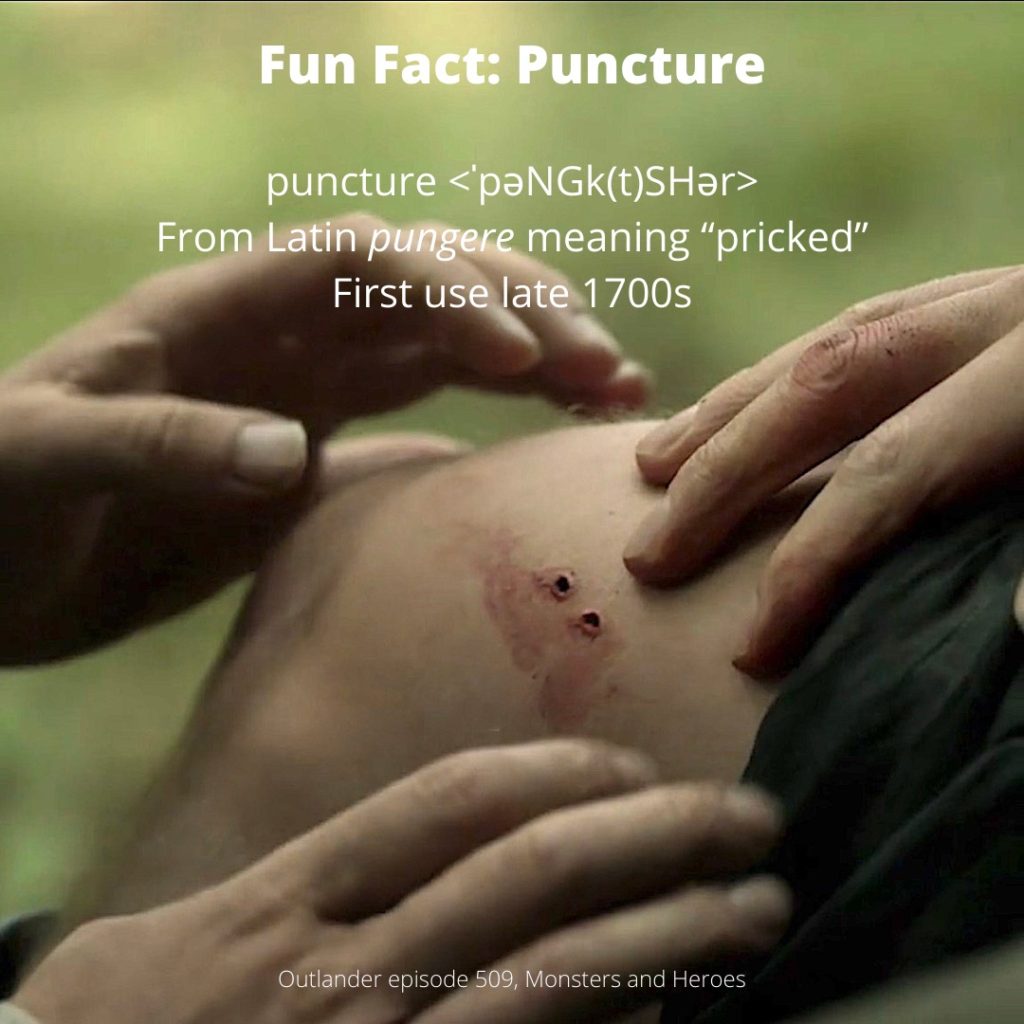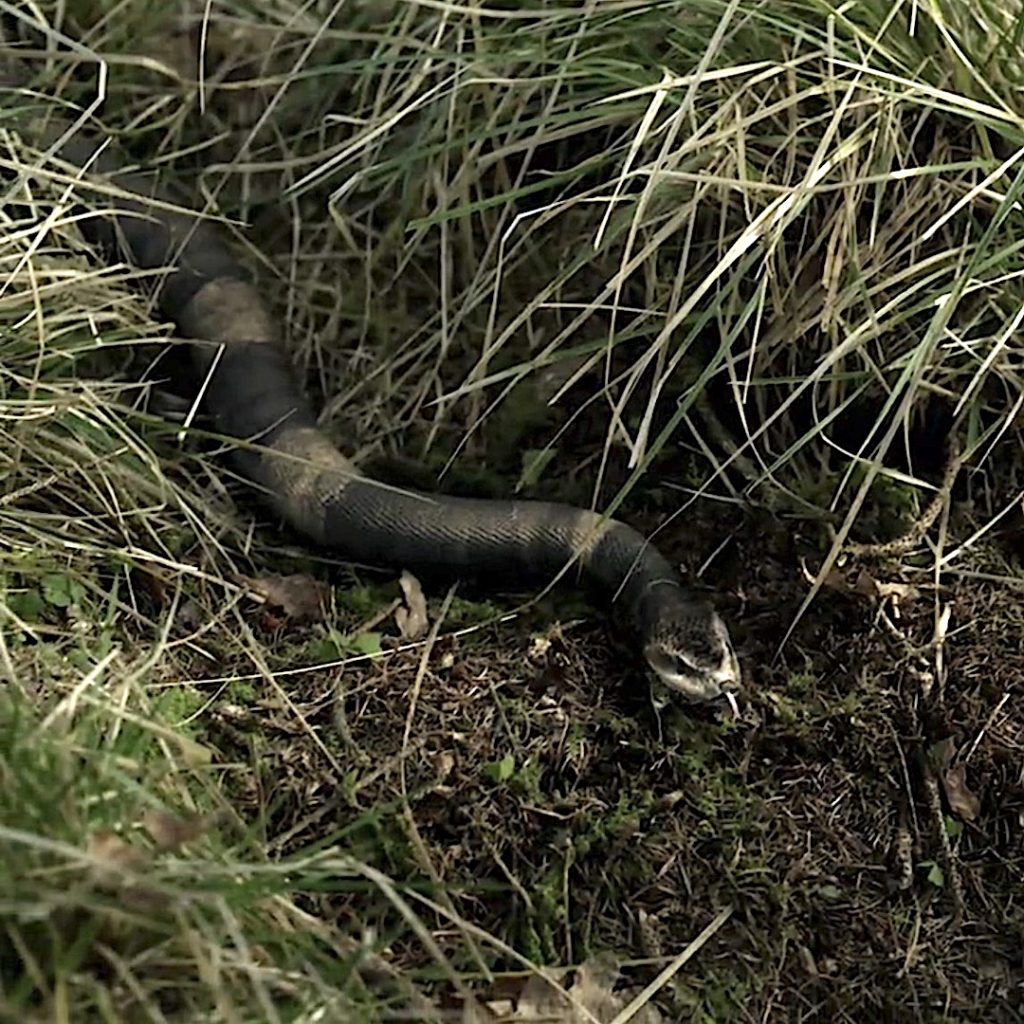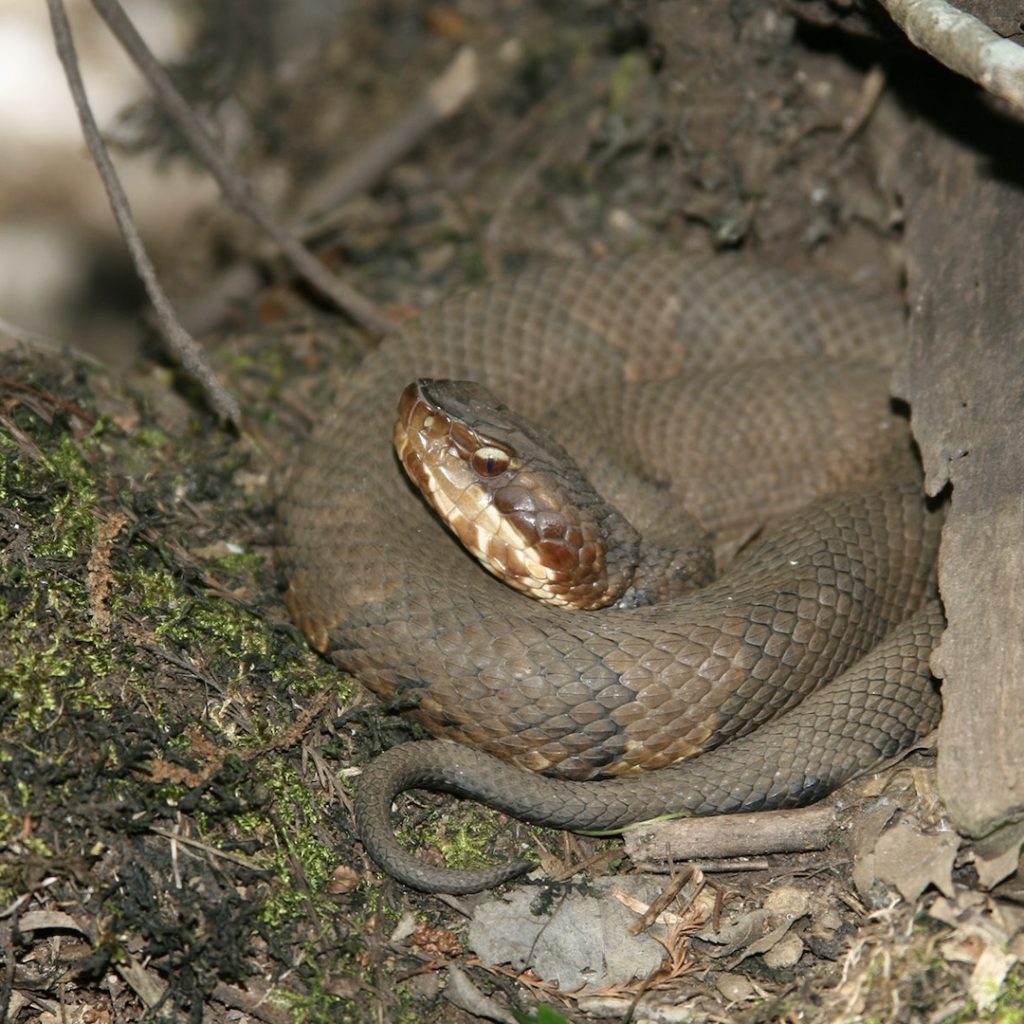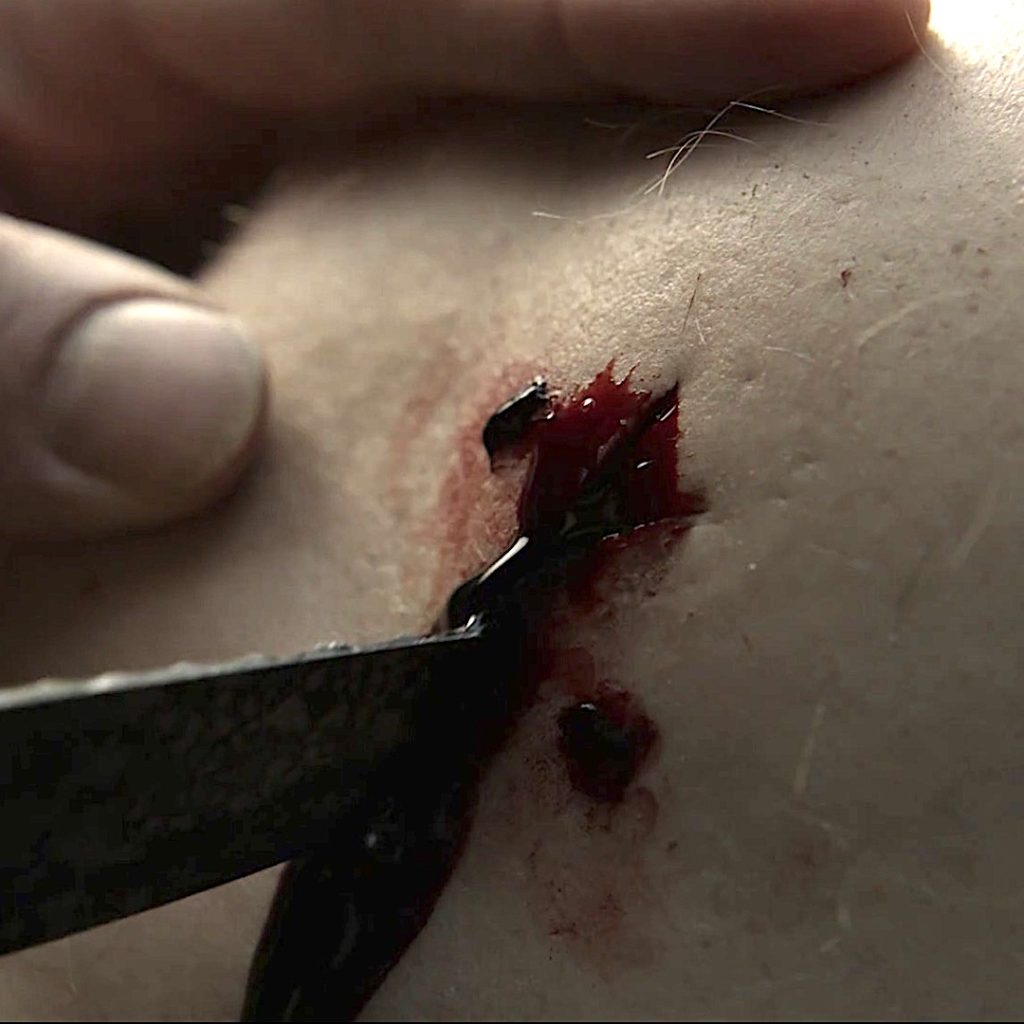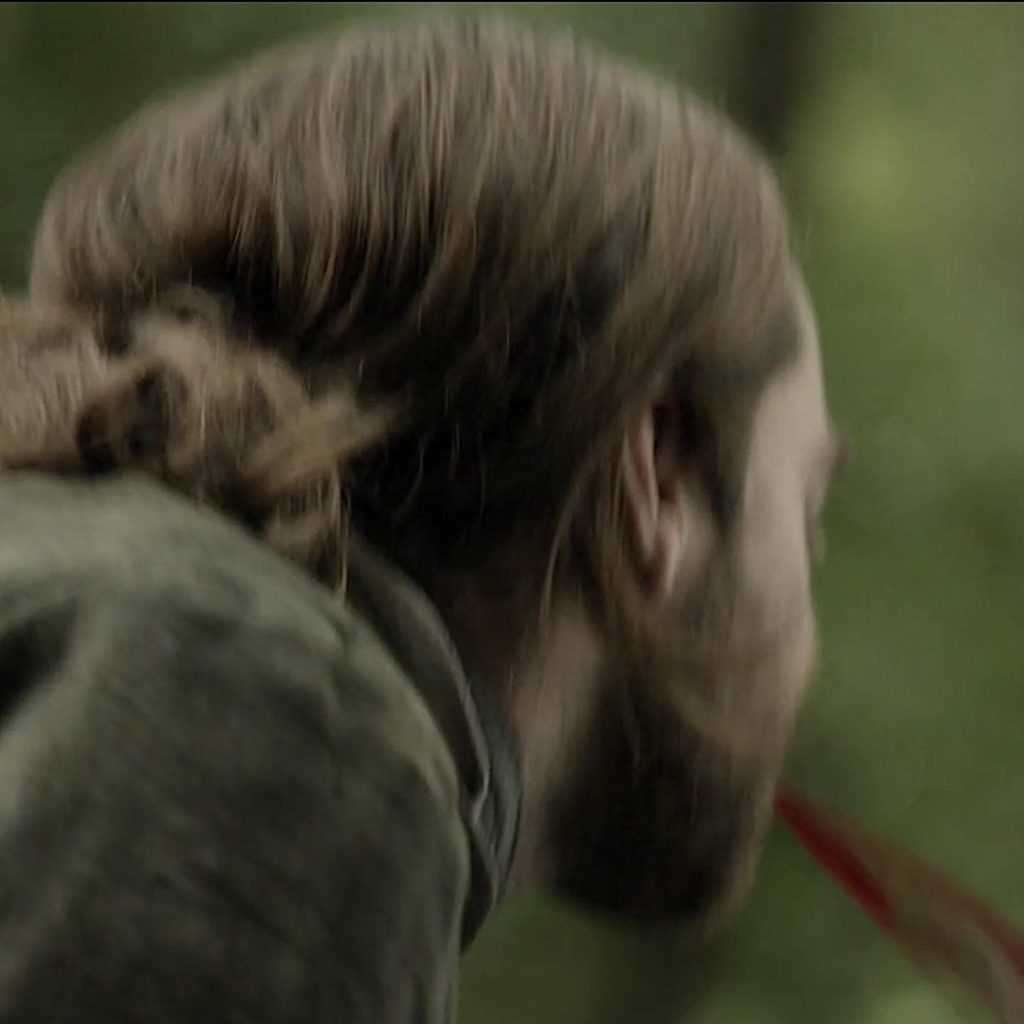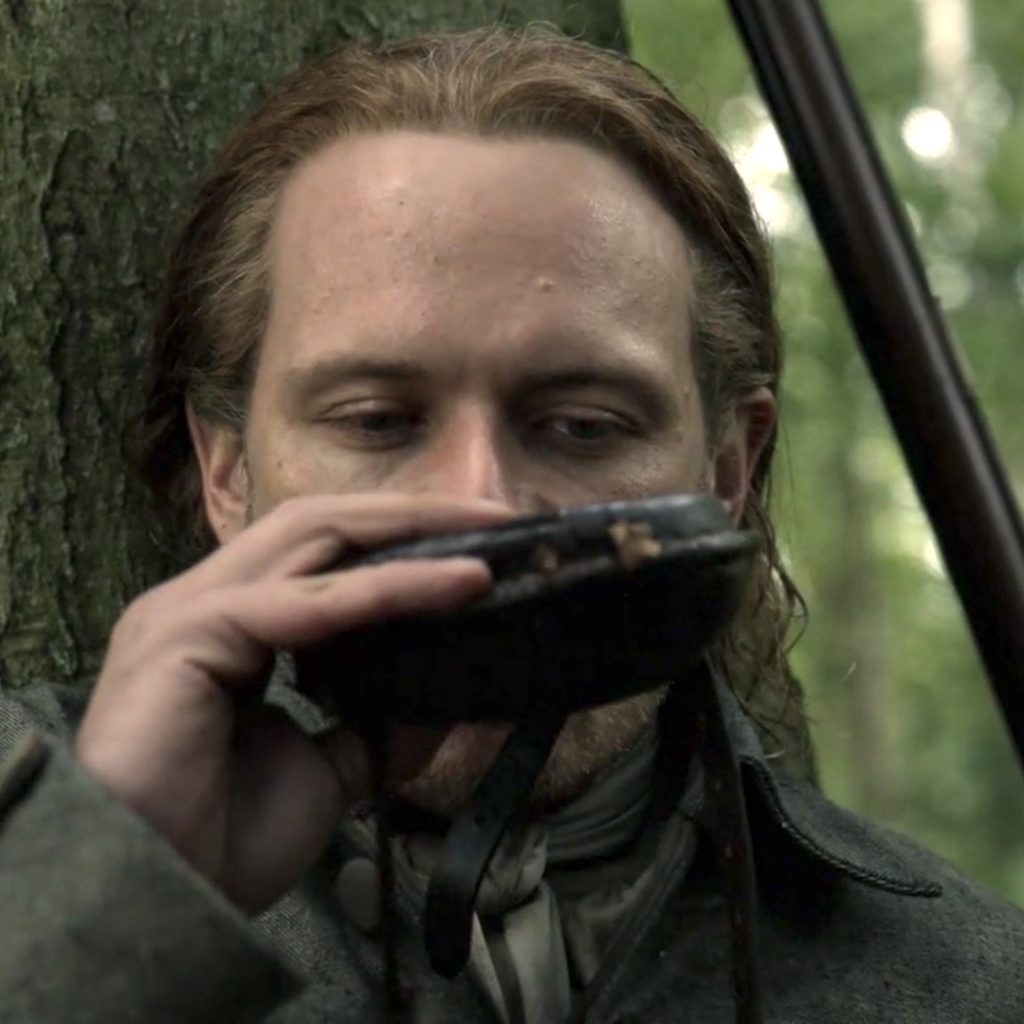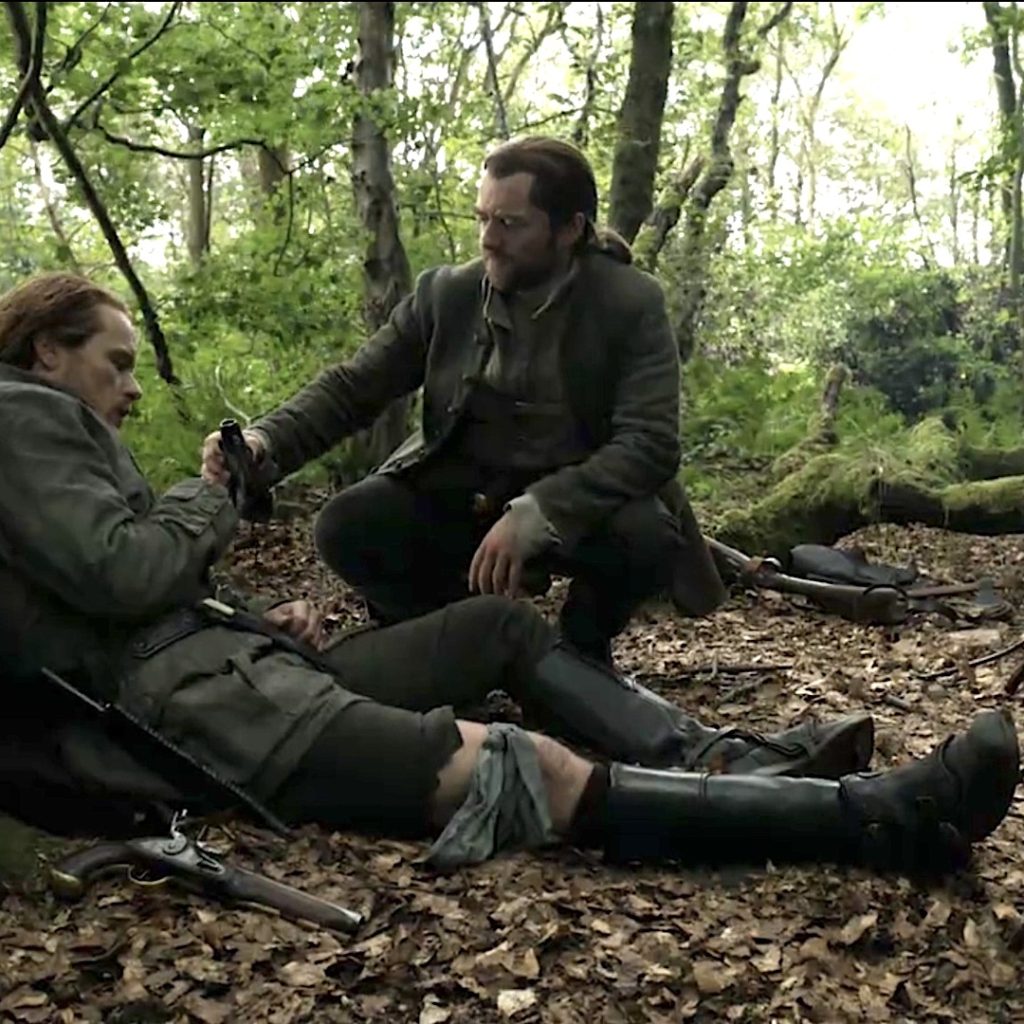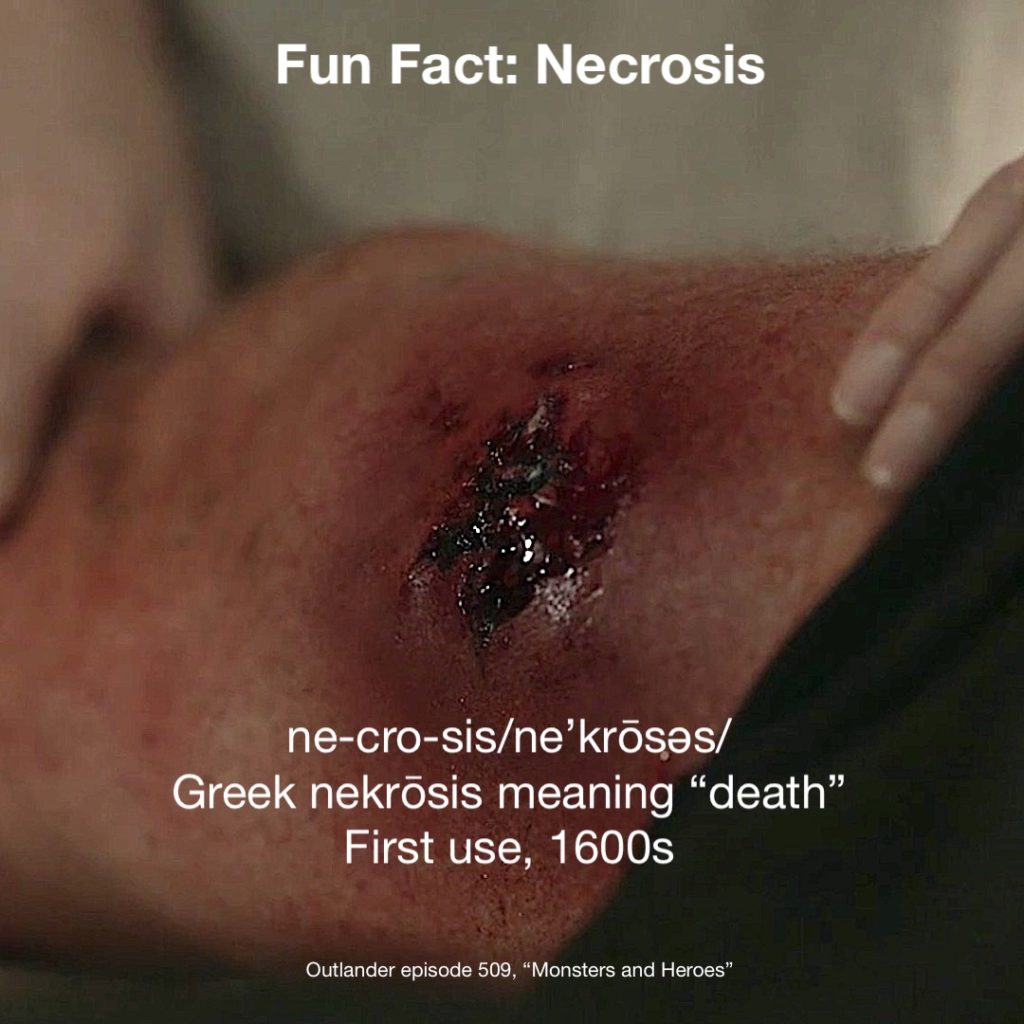
Anatomy Def: Necrosis means tissue death, as caused by disease, injury, or loss of blood supply.
Outlander Def: Jamie’s dreadful, blackening wound courtesy of a fang-bang! 🐍
Doubtless, Jamie’s horrific thigh wound in Outlander, episode 509, Monsters and Heroes, caused each of us to cringe! 😣
Learn about necrosis in Anatomy Lesson #37: Outlander Owies – Mars and Scars!
Depending on the species of snake, venoms cause predictable signs and symptoms. Within minutes to hours after the bite, Jamie exhibits most of the following:
-
- Puncture marks at the wound ✔︎
- Redness, swelling, bruising, bleeding, or blistering around the bite ✔︎
- Severe pain and tenderness at the site of the bite ✔︎
- Increased salivation and sweating ✔︎
- Labored breathing (in extreme cases, breathing may stop altogether) ✔︎
- Rapid heart rate, weak pulse, low blood pressure ✔︎
- Numbness or tingling around face and/or limbs ✔︎
- Disturbed vision (?)
- Nausea, vomiting, or diarrhea (?)
- Metallic, mint or rubber taste in mouth (?)
- Muscle twitches (?)
Back at the surgery, Claire quickly ascertains that Jamie’s wound is infected!
What might be the source(s) of the infection? Here are some ideas:
-
- Bacteria from the snake’s fangs and saliva
- Bacteria from Roger’s knife
- Bacteria in Roger’s saliva, as he drains Jamie like a vampire (Sorry, Bree)
- Dirty bandage
- Forest floor
- All the above? 😲
As recorded in The Fiery Cross (TFC), Claire determines that Jamie’s infected wound shows signs of septicemia, broadly known as blood poisoning.
The foot and ankle on the injured side were still warm and pink—or rather, red. That was a good sign, insofar as it meant the deeper circulation was intact. The problem was to improve circulation near the wound, enough to prevent a massive die-off and sloughing of tissue. The red streaks bothered me very much indeed, though; they could be only part of the hemorrhagic process, but it was more likely that they were the early signs of septicemia—blood poisoning.
Claire must halt the infection quickly because sepsis is life-threatening! Using the serpent’s fangs she injects Jamie with home-brewed penicillin to kill the blood-borne organisms.
Add insult to injury: the wound also exhibits necrosis! Claire evaluates the red-black tissue at the bite-site (see above image) – this tissue is dead.
What causes necrosis? Most likely, loss of blood supply. Necrotic tissue must be removed to avoid loss of muscle mass, gangrene, and possible amputation! 🦵Removing the dead tissue is a process known as debridement.
Alrightie, then. How might Claire debride the wound to remove dead tissue but spare the living? Surgical removal is always an an option but difficult to perform with the precision required. If she accidentally leaves necrotic tissue, it can still turn gangrenous. If she accidentally removes living tissue along with the dead, it further compromises Jamie’s thigh tissues. Hum…. 🤔
Well, here’s an idea….. 💡 How about someone rustles up some fly maggots, blow-fly maggots to be precise – Bree (in TFC) or Josiah (in ep 510)???
So, into the wound go the maggots and its suppertime! 😋 As gross as it seems, not only will maggots clean Jamie’s wound of necrotic tissue while sparing the living, his wound will heal faster. Truth!
“Nothing but a mouth and a gut,” declares Claire (TFC)!
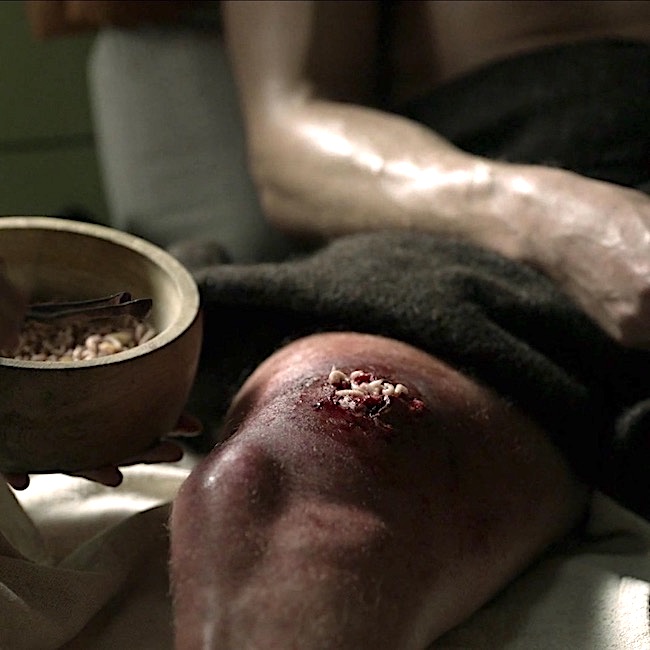
So, where did Claire get the idea of using maggots in Jamie’s wound? From her medical training, of course.
Maggot therapy is the introduction of live maggots into human or animal wounds to remove necrotic tissue but spare the living. (Psst….Just so you know, in today’s medicine, maggots are disinfected before use.) 🤫
Understand, maggot therapy is not new. Aboriginals of Australia and Mayan tribes in Central America frequently used fly larva to clean wounds. Clearly, these folks were observant of the world around them! 👀
When did Western medicine start to employ maggots? In the 1500s, some field surgeons (e.g. Ambroise Paré) observed that wounds infested with maggots healed faster but failed to credit the wee beasties as healers. The first documented therapeutic use of maggots in the US is credited to Confederate medical officer, Dr. J.F. Zacharias, who reported during the American Civil War that:
“Maggots … in a single day would clean a wound much better than any agents we had at our command … I am sure I saved many lives by their use.
Today, some modern hospitals employ medical maggots (Maggots, LLC? 😜) to solve otherwise vexing cases that do not respond to traditional therapies.
One last note – do we believe that a poisonous snake bit Jamie? Nope.
I love Jamie’s (Diana’s) succinct and accurate comparison of venom vs. poison; from Diana’s fourth book, Drums of Autumn:
“Venemous,” Jamie corrected him. “If it bites you and makes ye sick, it’s venomous; if you bite it and it makes ye sick, it’s poisonous.”
Read about Jamie’s horrific snake bite injury and Claire’s therapy in Diana’s fifth book, The Fiery Cross.
“It looks nastier than it is,” I said reassuringly, hearing Marsali’s unguarded gasp at the sight. That was true, but the reality was nasty enough. The slash marks were crusted black at the edges, but still gaped. Instead of the sealing and granulation of normal healing, they were beginning to erode, the exposed tissues oozing pus. The flesh around the wounds was hugely swollen, black and mottled with sinister reddish streaks. I bit my lip, frowning as I considered the situation. I didn’t know what kind of snake had bitten him—not that it made much difference, with no antivenin for treatment—but it had plainly had a powerful hemolytic toxin. Tiny blood vessels had ruptured and bled all over his body—internally, as well as externally—
See Jamie receive maggot therapy for his necrotic wound in Outlander, episode 509, Monsters and Heroes.
Thank you, Claire!
Be well, Jamie! 🙏🏻
The deeply grateful,
Outlander Anatomist
Follow me on:
-
- Twitter: @OutLandAnatomy
- Facebook: OutlandishAnatomyLessons
- Instagram: @outlanderanatomy
- Tumblr: @outlanderanatomy
- Youtube: Outlander Anatomy
Photo and Video Credits: Sony/Starz

